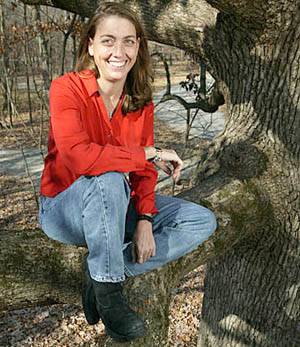Hunting chimpanzees: Pruetz to discuss breakthrough discoveries
By Marc Speir
University News Service
October 31, 2007
 Jill Pruetz |
Primatologist Jill Pruetz, a Texas State University-San Marcos alumnus who recently recorded the first evidence of chimpanzees using tools to hunt, will speak at the university Monday, Nov. 5.
Pruetz’s speech is titled, “Redefining Chimpanzees: New Research on Savanna Chimpanzees.” The lecture will begin at 7 p.m. in the Alkek Library teaching theatre on campus. The free presentation is open to the public and marks the first in a new
Pruetz, an assistant professor of anthropology at
A March 6 issue of Current Biology reports that Pruetz found evidence in the West African nation of
Pruetz’s study, funded by the National Geographic Society, is the first record of chimpanzees hunting with tools and the first account of habitual tool use by non-humans while hunting other vertebrates. It’s also the first report of hunting by female chimpanzees.
While female chimpanzees are known to make and use tools to extract insects from mounds of earth and crack open nuts for consumption, hunting was always considered a male activity. Pruetz documented 22 cases of female and juvenile chimpanzees fashioning tools such as spears to use in hunting smaller primates in hollow branches and tree trunks.
The findings support a theory that females may have played a role in the evolution of tool technology in early humans, including a modernization of hunting and gathering techniques. The evidence comes at a time when our closest living relatives face extinction in many areas of the world.
“The observation that individuals hunting with tools include females and immature chimpanzees suggests that scientists should rethink traditional explanations for the evolution of such behavior in the human lineage,” said Beth Erhart, assistant professor of anthropology at
Pruetz is also involved in teaching and conservation in the tropics. She is co-director of the non-profit organization DANTA and affiliated with the El Zota Biological Field Station in
More information is available by contacting Pam Lemoine in the